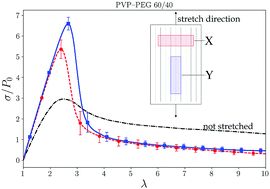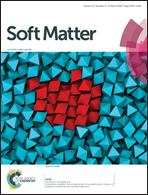Soft to tough: ordering in and tack of polymeric materials†
Abstract
In the present paper, adhesive properties (in terms of practical work of adhesion, Wa, and maximum stress in probe tack test) of blends of polyvinyl pyrrolidone (PVP) with polyethylene glycol (PEG-400) are studied at different level of stretching stress, applied perpendicular to the probe. The anisotropic behavior in both directions is investigated. Upon stretching, blends of 50/50 wt% PVP–PEG demonstrate little decrease in tack and little increase in maximum debonding stress. Whereas for more cohesive blends like PVP–PEG mixtures with down to 35 wt% of PEG, a significant reduction in Wa at the size of an order of a magnitude is observed. Similar behavior is measured with a commercial product from 3M with the trade name “Command”. For the first time, the anisotropy of probe tack properties of two identical strips after stretching is demonstrated via a specially designed quasi-2D setup, where the external force is applied either along or transverse the long side of the quasi-2D substrate, resulting in a significant difference in the measured probe tack curves. This phenomenon has been described by the block model, developed by Yamaguchi et al. We extended the block model by introducing the stretching stress into the model. The differences are explained by the difference in kinetics of the cavity growth between the two directions.



 Please wait while we load your content...
Please wait while we load your content...